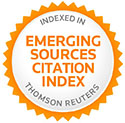Comparisons of inequality in Argentine Sign Language. A descriptive approach
Abstract
According to Quer et al (2017), in cognitive or semantic terms, comparisons can be defined as a mental act by which two entities are assigned a position on a scale: if the the positions on the scale are different, we will speak of comparisons of inequality; if they occupy the same position, we will have a comparisons of equality. In this paper we propose to make a descriptive approach to the comparative constructions of inequality in Argentine Sign Language (LSA). The absence of description of comparative constructions is general in the field of sign languages (LLSS), with the exception of Italian Sign Language and Turkish Sign Language. Our preliminary observations agree with the descriptions of these two LLSS regarding the various ways of expressing inequality comparison. In this regard, we observe three options, which can co-occur in the same sentence. On the one hand, the comparison can be expressed through the use of a scalar manual sign that is incorporated into the nucleus of the comparison. On the other hand, it is possible to use the comparative quantifier sign MÁS, adjacent to the nucleus of the comparison or compared notion. Finally, the comparison can be expressed through a locative strategy together with deictic signs.Downloads
References
Cvejanov, Sandra. 2018. “Concordancia verbal locativa y delimitación en lengua de señas argentina”. Convergencias, Revista de Educación 1.2: 61-81.
Cvejanov, Sandra y Mónica Curiel. 2006. “Sintaxis y simultaneidad en lengua de señas argentina: una aproximación descriptiva”. Revista de Lengua y Literatura 34: 99-112.
Cvejanov, Sandra y Rocío A. Martínez. 2022. Introducción al dossier “Estudios gramaticales sobre lenguas de señas de América Latina y el Caribe. Parte I”. En Quintú Quimün, Revista de lingüística 6: pp.1-11. https://doi.org/10.5281/zenodo.7376393.
Cvejanov, Sandra y M. Ignacia Massone. 2012. “Aportes a la descripción del marcador de concordancia sujeto-objeto de persona en lengua de señas argentina”. En M. Ignacia Massone y Rocío Martínez Curso de Lengua de Señas Argentina. Parte IV. Mendoza/Berlín: Cultura Sorda.
Dixon, Robert M.W. 2008. “Comparative constructions: A cross-linguistic typology”. Studies in Language 32.4: 787-817.
Dixon, Robert M.W. 2012. Basic Linguistic Theory: Further Grammatical Topics. Vol III. Oxford: Oxford University Press.
Gutiérrez Ordoñez, Salvador. 1997. Estructuras comparativas. Madrid. Arco/Libros.
Lillo-Martin, Diane. 1991. Universal Grammar and American Sign Language: Setting the Null Argument Parameters. Dordrecht: Kluwer Academic Publishers.
Massone, M. Ignacia. 1996. “Gramática y léxico de la Lengua de Señas Argentina”. Tesis doctoral, Universidad de Buenos Aires.
Massone, M. Ignacia. 2000. La conversación en LSA. Buenos Aires: Edicial.
Massone. M. Ignacia y Rocío Martínez (Coord.). 2012. Curso de Lengua de Señas Argentina. Mendoza/Berlín: Cultura Sorda.
Quer, Josep, Carlo Cecchetto, Caterina Donati, Carlo Geraci, Melten Kelepir, Roland Pfau y Markus Steinbach (Dir.). 2017. Sign Grammar Blueprint: A Guide to Sign Language Grammar Writing. Berlin: De Gruyter Mouton.
Real Academia Española y Asociación de Academias de la Lengua Española. 2009. “Construcciones comparativas, superlativas y consecutivas”. En Nueva gramática de la lengua española, cap. 45. Madrid: Espasa.
Stassen, Leon. 1985. Comparison and Universal Grammar. Oxford: Basil Blackwell.
Stassen, Leon. 2013. “Comparative constructions”. En Matthew S. Dryer y Martin Haspelmath (eds.), The World Atlas of Language Structures Online. Leipzig: Max Planck Institute for Evolutionary Anthropology.
Stolz, Thomas. 2013. Competing Comparative Constructions in Europe. Berlin: Akademie-Verlag.
Treis, Yvonne. 2018. “Comparative Constructions: An introduction”. Linguistic Discovery 16.1: i-xxvi.
- Authors keep the copyright and give the journal the right of the first publication, with the work registered with the Creative Commons Attribution-ShareAlike 4.0 International License, which allows third parties to use what is published whenever they mention the authorship of the work and the first publication in this magazine.
- Authors can make other independent and additional contractual agreements for the non-exclusive distribution of the article published in this journal (eg, include it in an institutional repository or publish it in a book) as long as they clearly indicate that the work It was published for the first time in this magazine.
- Authors are allowed and recommended to publish their work on the Internet (for example on institutional or personal pages).

















